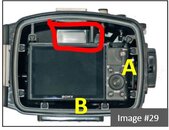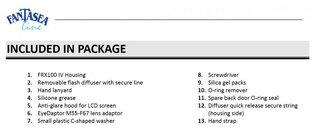I'm not a still camera enthusiast - I shoot video. But a lot of my friends are so I have a working knowledge. If I've got something wrong - anyone please feel free to correct it.
No possibility of leaking is impossible to guarantee since most times that's operator error. Just be thorough about maintaining and inspecting the o-ring each time you seal the camera in it and you shouldn't have any problems.
The Fantasea has a water alarm which might save the camera if you can surface quickly enough
safely. In my experience (buddy has had two housing leak) that's not really possible.
The obvious difference between the housings is the Ikelite
can not drive an external flash. And since it's a solid body housing, the camera's internal flash is useless also. If you read the fine print what they're suggesting instead is purchasing a constantly on light/video light to use your camera's excellent video option plus you can use the same light to illuminate still photos - just not for fast action capture like a flash will.
Obviously the Fantasea being black has the same issue <- (Incorrect - see correction below) but they provide two fiber optic ports that can be used to drive an external flash if needed.
Both have all the controls needed for the pool work certainly and non-flash other u/w photography. 200' depth rating means they're both good to around that depth - certainly to rec limits of 132'. Either accepts optional filters and close-up lenses that screw onto the front of the port if needed.
At 50' depths in clear blue water, you
might get very acceptable results with just a "red" filter that also attaches to the front port as needed. Otherwise everything below about 20' will be exceedingly blue and maybe not correctable in photo editing software during post-processing.
Ikelite also makes one of their conventional housings for your camera at $549. Being clear you can see leaks during the dive and it will drive an external strobe if wanted since it has a fiber optic port/connector.
Ikelite Underwater Housing for Sony Cyber-shot RX100 IV 6116.14 Also being clear your camera's flash will provide some lighting support. My buddy has one for his Canon - it's a quality housing.
Above that price if you're looking at
Nauticam or the
Sea & Sea housing - the 2-3x base price generally means they're aluminum, often with interchangeable ports and in Nauticam's case you can check the seal pre-dive by pulling a vacuum inside the housing. Plus they add additional controls, a flash controller etc. on some models. All that costs more.






